Gender Equality: Evaluating Dream vs. Realistic Ambition Today
VerifiedAdded on 2023/06/08
|8
|2619
|451
Essay
AI Summary
This essay examines the complexities surrounding gender equality, questioning whether it is a realistic ambition or an unattainable dream. It highlights the prevalence of gender discrimination in various forms, including violence against women, unequal opportunities in education and employment, and the disproportionate burden of unpaid care work. The essay also explores the role of government policies and international goals, such as the Sustainable Development Goals, in promoting gender equality. While acknowledging the progress made in raising awareness and enacting legislation, the essay emphasizes the need for continued efforts to address deeply ingrained social norms and discriminatory practices. It concludes that achieving gender equality requires a multi-faceted approach involving social pressure, government intervention, and a recognition of the diverse needs and identities of all individuals. Desklib offers a platform to explore similar essays and resources for further understanding.
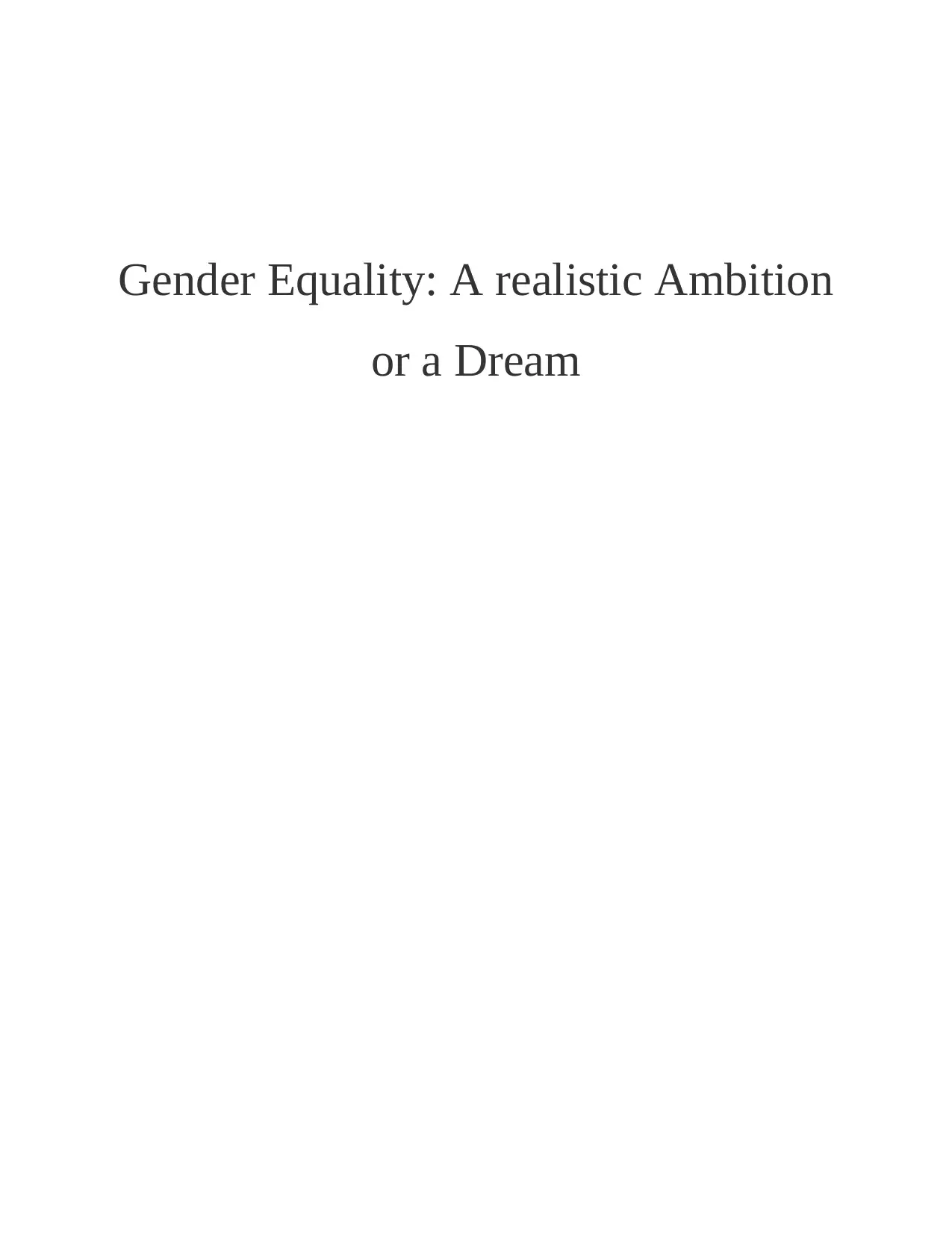
Gender Equality: A realistic Ambition
or a Dream
or a Dream
Paraphrase This Document
Need a fresh take? Get an instant paraphrase of this document with our AI Paraphraser
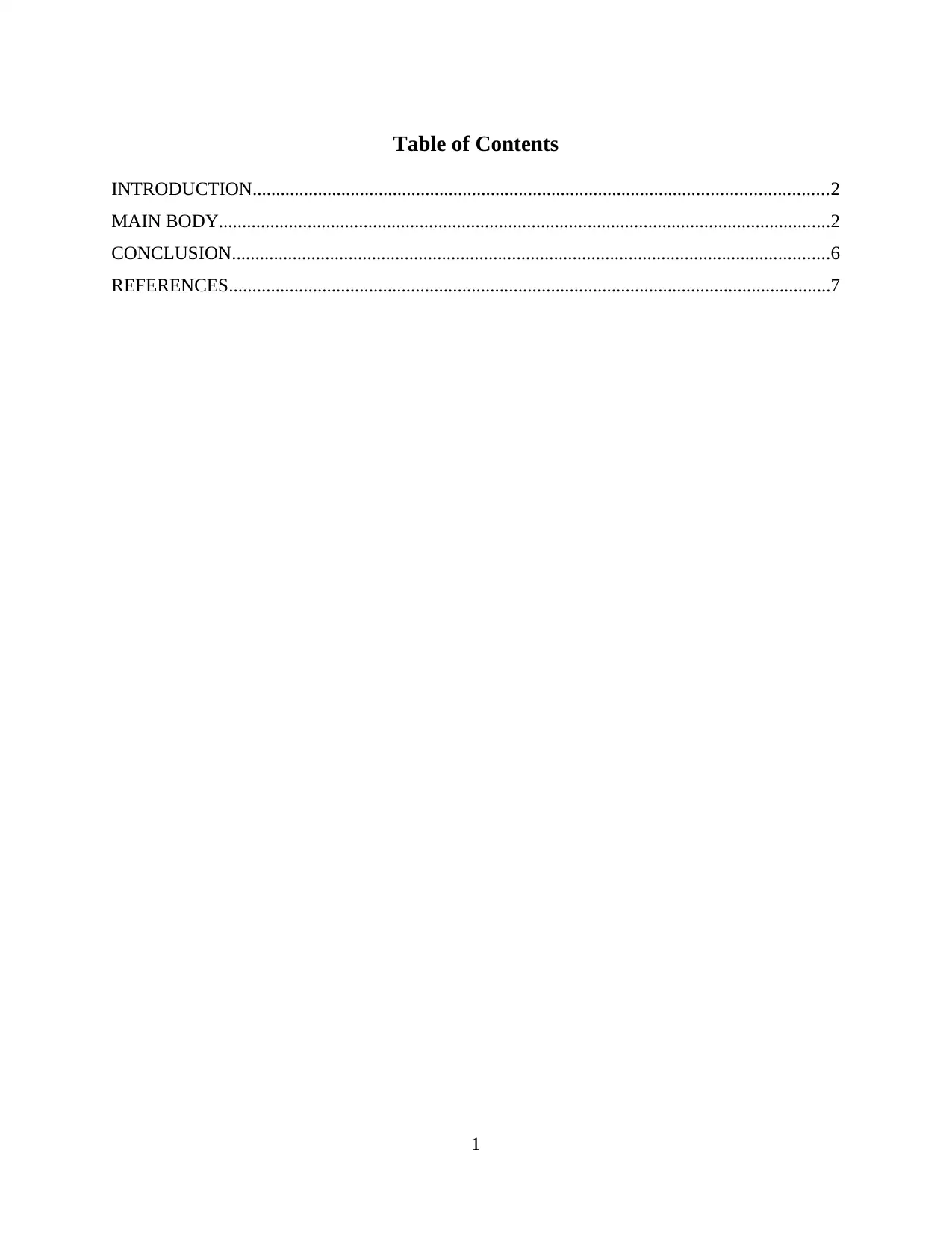
Table of Contents
INTRODUCTION...........................................................................................................................2
MAIN BODY...................................................................................................................................2
CONCLUSION................................................................................................................................6
REFERENCES.................................................................................................................................7
1
INTRODUCTION...........................................................................................................................2
MAIN BODY...................................................................................................................................2
CONCLUSION................................................................................................................................6
REFERENCES.................................................................................................................................7
1
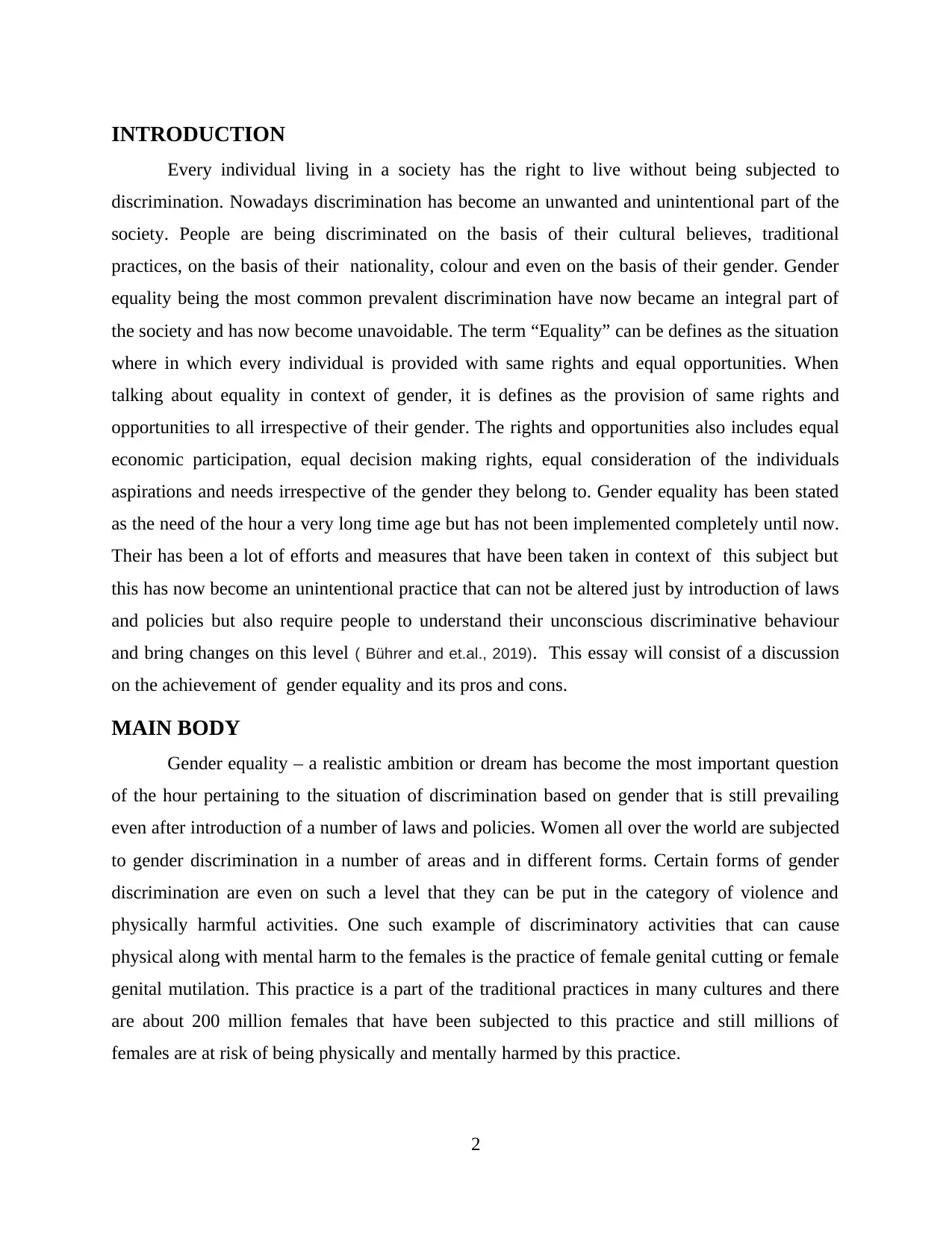
INTRODUCTION
Every individual living in a society has the right to live without being subjected to
discrimination. Nowadays discrimination has become an unwanted and unintentional part of the
society. People are being discriminated on the basis of their cultural believes, traditional
practices, on the basis of their nationality, colour and even on the basis of their gender. Gender
equality being the most common prevalent discrimination have now became an integral part of
the society and has now become unavoidable. The term “Equality” can be defines as the situation
where in which every individual is provided with same rights and equal opportunities. When
talking about equality in context of gender, it is defines as the provision of same rights and
opportunities to all irrespective of their gender. The rights and opportunities also includes equal
economic participation, equal decision making rights, equal consideration of the individuals
aspirations and needs irrespective of the gender they belong to. Gender equality has been stated
as the need of the hour a very long time age but has not been implemented completely until now.
Their has been a lot of efforts and measures that have been taken in context of this subject but
this has now become an unintentional practice that can not be altered just by introduction of laws
and policies but also require people to understand their unconscious discriminative behaviour
and bring changes on this level ( Bührer and et.al., 2019). This essay will consist of a discussion
on the achievement of gender equality and its pros and cons.
MAIN BODY
Gender equality – a realistic ambition or dream has become the most important question
of the hour pertaining to the situation of discrimination based on gender that is still prevailing
even after introduction of a number of laws and policies. Women all over the world are subjected
to gender discrimination in a number of areas and in different forms. Certain forms of gender
discrimination are even on such a level that they can be put in the category of violence and
physically harmful activities. One such example of discriminatory activities that can cause
physical along with mental harm to the females is the practice of female genital cutting or female
genital mutilation. This practice is a part of the traditional practices in many cultures and there
are about 200 million females that have been subjected to this practice and still millions of
females are at risk of being physically and mentally harmed by this practice.
2
Every individual living in a society has the right to live without being subjected to
discrimination. Nowadays discrimination has become an unwanted and unintentional part of the
society. People are being discriminated on the basis of their cultural believes, traditional
practices, on the basis of their nationality, colour and even on the basis of their gender. Gender
equality being the most common prevalent discrimination have now became an integral part of
the society and has now become unavoidable. The term “Equality” can be defines as the situation
where in which every individual is provided with same rights and equal opportunities. When
talking about equality in context of gender, it is defines as the provision of same rights and
opportunities to all irrespective of their gender. The rights and opportunities also includes equal
economic participation, equal decision making rights, equal consideration of the individuals
aspirations and needs irrespective of the gender they belong to. Gender equality has been stated
as the need of the hour a very long time age but has not been implemented completely until now.
Their has been a lot of efforts and measures that have been taken in context of this subject but
this has now become an unintentional practice that can not be altered just by introduction of laws
and policies but also require people to understand their unconscious discriminative behaviour
and bring changes on this level ( Bührer and et.al., 2019). This essay will consist of a discussion
on the achievement of gender equality and its pros and cons.
MAIN BODY
Gender equality – a realistic ambition or dream has become the most important question
of the hour pertaining to the situation of discrimination based on gender that is still prevailing
even after introduction of a number of laws and policies. Women all over the world are subjected
to gender discrimination in a number of areas and in different forms. Certain forms of gender
discrimination are even on such a level that they can be put in the category of violence and
physically harmful activities. One such example of discriminatory activities that can cause
physical along with mental harm to the females is the practice of female genital cutting or female
genital mutilation. This practice is a part of the traditional practices in many cultures and there
are about 200 million females that have been subjected to this practice and still millions of
females are at risk of being physically and mentally harmed by this practice.
2
⊘ This is a preview!⊘
Do you want full access?
Subscribe today to unlock all pages.

Trusted by 1+ million students worldwide
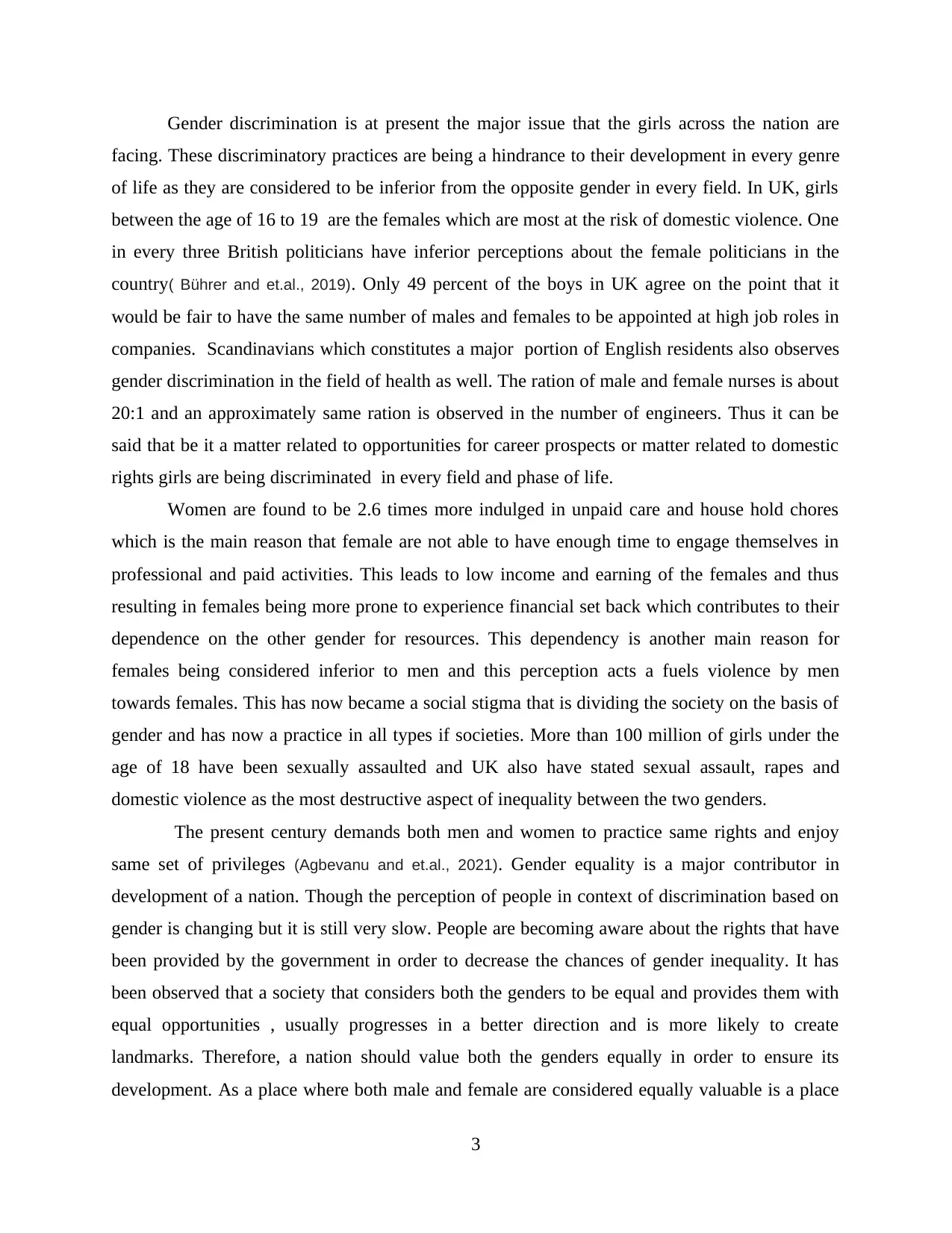
Gender discrimination is at present the major issue that the girls across the nation are
facing. These discriminatory practices are being a hindrance to their development in every genre
of life as they are considered to be inferior from the opposite gender in every field. In UK, girls
between the age of 16 to 19 are the females which are most at the risk of domestic violence. One
in every three British politicians have inferior perceptions about the female politicians in the
country( Bührer and et.al., 2019). Only 49 percent of the boys in UK agree on the point that it
would be fair to have the same number of males and females to be appointed at high job roles in
companies. Scandinavians which constitutes a major portion of English residents also observes
gender discrimination in the field of health as well. The ration of male and female nurses is about
20:1 and an approximately same ration is observed in the number of engineers. Thus it can be
said that be it a matter related to opportunities for career prospects or matter related to domestic
rights girls are being discriminated in every field and phase of life.
Women are found to be 2.6 times more indulged in unpaid care and house hold chores
which is the main reason that female are not able to have enough time to engage themselves in
professional and paid activities. This leads to low income and earning of the females and thus
resulting in females being more prone to experience financial set back which contributes to their
dependence on the other gender for resources. This dependency is another main reason for
females being considered inferior to men and this perception acts a fuels violence by men
towards females. This has now became a social stigma that is dividing the society on the basis of
gender and has now a practice in all types if societies. More than 100 million of girls under the
age of 18 have been sexually assaulted and UK also have stated sexual assault, rapes and
domestic violence as the most destructive aspect of inequality between the two genders.
The present century demands both men and women to practice same rights and enjoy
same set of privileges (Agbevanu and et.al., 2021). Gender equality is a major contributor in
development of a nation. Though the perception of people in context of discrimination based on
gender is changing but it is still very slow. People are becoming aware about the rights that have
been provided by the government in order to decrease the chances of gender inequality. It has
been observed that a society that considers both the genders to be equal and provides them with
equal opportunities , usually progresses in a better direction and is more likely to create
landmarks. Therefore, a nation should value both the genders equally in order to ensure its
development. As a place where both male and female are considered equally valuable is a place
3
facing. These discriminatory practices are being a hindrance to their development in every genre
of life as they are considered to be inferior from the opposite gender in every field. In UK, girls
between the age of 16 to 19 are the females which are most at the risk of domestic violence. One
in every three British politicians have inferior perceptions about the female politicians in the
country( Bührer and et.al., 2019). Only 49 percent of the boys in UK agree on the point that it
would be fair to have the same number of males and females to be appointed at high job roles in
companies. Scandinavians which constitutes a major portion of English residents also observes
gender discrimination in the field of health as well. The ration of male and female nurses is about
20:1 and an approximately same ration is observed in the number of engineers. Thus it can be
said that be it a matter related to opportunities for career prospects or matter related to domestic
rights girls are being discriminated in every field and phase of life.
Women are found to be 2.6 times more indulged in unpaid care and house hold chores
which is the main reason that female are not able to have enough time to engage themselves in
professional and paid activities. This leads to low income and earning of the females and thus
resulting in females being more prone to experience financial set back which contributes to their
dependence on the other gender for resources. This dependency is another main reason for
females being considered inferior to men and this perception acts a fuels violence by men
towards females. This has now became a social stigma that is dividing the society on the basis of
gender and has now a practice in all types if societies. More than 100 million of girls under the
age of 18 have been sexually assaulted and UK also have stated sexual assault, rapes and
domestic violence as the most destructive aspect of inequality between the two genders.
The present century demands both men and women to practice same rights and enjoy
same set of privileges (Agbevanu and et.al., 2021). Gender equality is a major contributor in
development of a nation. Though the perception of people in context of discrimination based on
gender is changing but it is still very slow. People are becoming aware about the rights that have
been provided by the government in order to decrease the chances of gender inequality. It has
been observed that a society that considers both the genders to be equal and provides them with
equal opportunities , usually progresses in a better direction and is more likely to create
landmarks. Therefore, a nation should value both the genders equally in order to ensure its
development. As a place where both male and female are considered equally valuable is a place
3
Paraphrase This Document
Need a fresh take? Get an instant paraphrase of this document with our AI Paraphraser
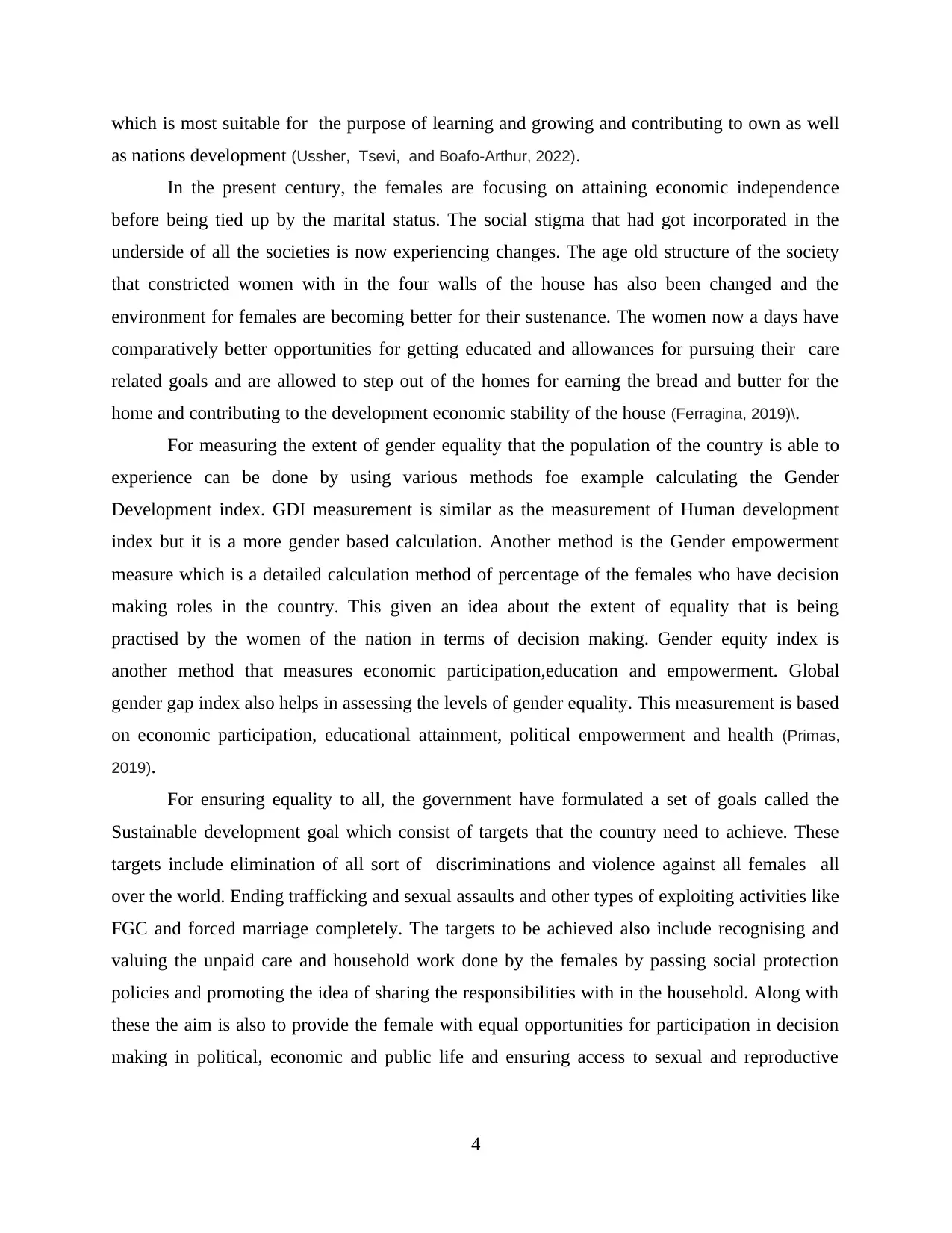
which is most suitable for the purpose of learning and growing and contributing to own as well
as nations development (Ussher, Tsevi, and Boafo-Arthur, 2022).
In the present century, the females are focusing on attaining economic independence
before being tied up by the marital status. The social stigma that had got incorporated in the
underside of all the societies is now experiencing changes. The age old structure of the society
that constricted women with in the four walls of the house has also been changed and the
environment for females are becoming better for their sustenance. The women now a days have
comparatively better opportunities for getting educated and allowances for pursuing their care
related goals and are allowed to step out of the homes for earning the bread and butter for the
home and contributing to the development economic stability of the house (Ferragina, 2019)\.
For measuring the extent of gender equality that the population of the country is able to
experience can be done by using various methods foe example calculating the Gender
Development index. GDI measurement is similar as the measurement of Human development
index but it is a more gender based calculation. Another method is the Gender empowerment
measure which is a detailed calculation method of percentage of the females who have decision
making roles in the country. This given an idea about the extent of equality that is being
practised by the women of the nation in terms of decision making. Gender equity index is
another method that measures economic participation,education and empowerment. Global
gender gap index also helps in assessing the levels of gender equality. This measurement is based
on economic participation, educational attainment, political empowerment and health (Primas,
2019).
For ensuring equality to all, the government have formulated a set of goals called the
Sustainable development goal which consist of targets that the country need to achieve. These
targets include elimination of all sort of discriminations and violence against all females all
over the world. Ending trafficking and sexual assaults and other types of exploiting activities like
FGC and forced marriage completely. The targets to be achieved also include recognising and
valuing the unpaid care and household work done by the females by passing social protection
policies and promoting the idea of sharing the responsibilities with in the household. Along with
these the aim is also to provide the female with equal opportunities for participation in decision
making in political, economic and public life and ensuring access to sexual and reproductive
4
as nations development (Ussher, Tsevi, and Boafo-Arthur, 2022).
In the present century, the females are focusing on attaining economic independence
before being tied up by the marital status. The social stigma that had got incorporated in the
underside of all the societies is now experiencing changes. The age old structure of the society
that constricted women with in the four walls of the house has also been changed and the
environment for females are becoming better for their sustenance. The women now a days have
comparatively better opportunities for getting educated and allowances for pursuing their care
related goals and are allowed to step out of the homes for earning the bread and butter for the
home and contributing to the development economic stability of the house (Ferragina, 2019)\.
For measuring the extent of gender equality that the population of the country is able to
experience can be done by using various methods foe example calculating the Gender
Development index. GDI measurement is similar as the measurement of Human development
index but it is a more gender based calculation. Another method is the Gender empowerment
measure which is a detailed calculation method of percentage of the females who have decision
making roles in the country. This given an idea about the extent of equality that is being
practised by the women of the nation in terms of decision making. Gender equity index is
another method that measures economic participation,education and empowerment. Global
gender gap index also helps in assessing the levels of gender equality. This measurement is based
on economic participation, educational attainment, political empowerment and health (Primas,
2019).
For ensuring equality to all, the government have formulated a set of goals called the
Sustainable development goal which consist of targets that the country need to achieve. These
targets include elimination of all sort of discriminations and violence against all females all
over the world. Ending trafficking and sexual assaults and other types of exploiting activities like
FGC and forced marriage completely. The targets to be achieved also include recognising and
valuing the unpaid care and household work done by the females by passing social protection
policies and promoting the idea of sharing the responsibilities with in the household. Along with
these the aim is also to provide the female with equal opportunities for participation in decision
making in political, economic and public life and ensuring access to sexual and reproductive
4
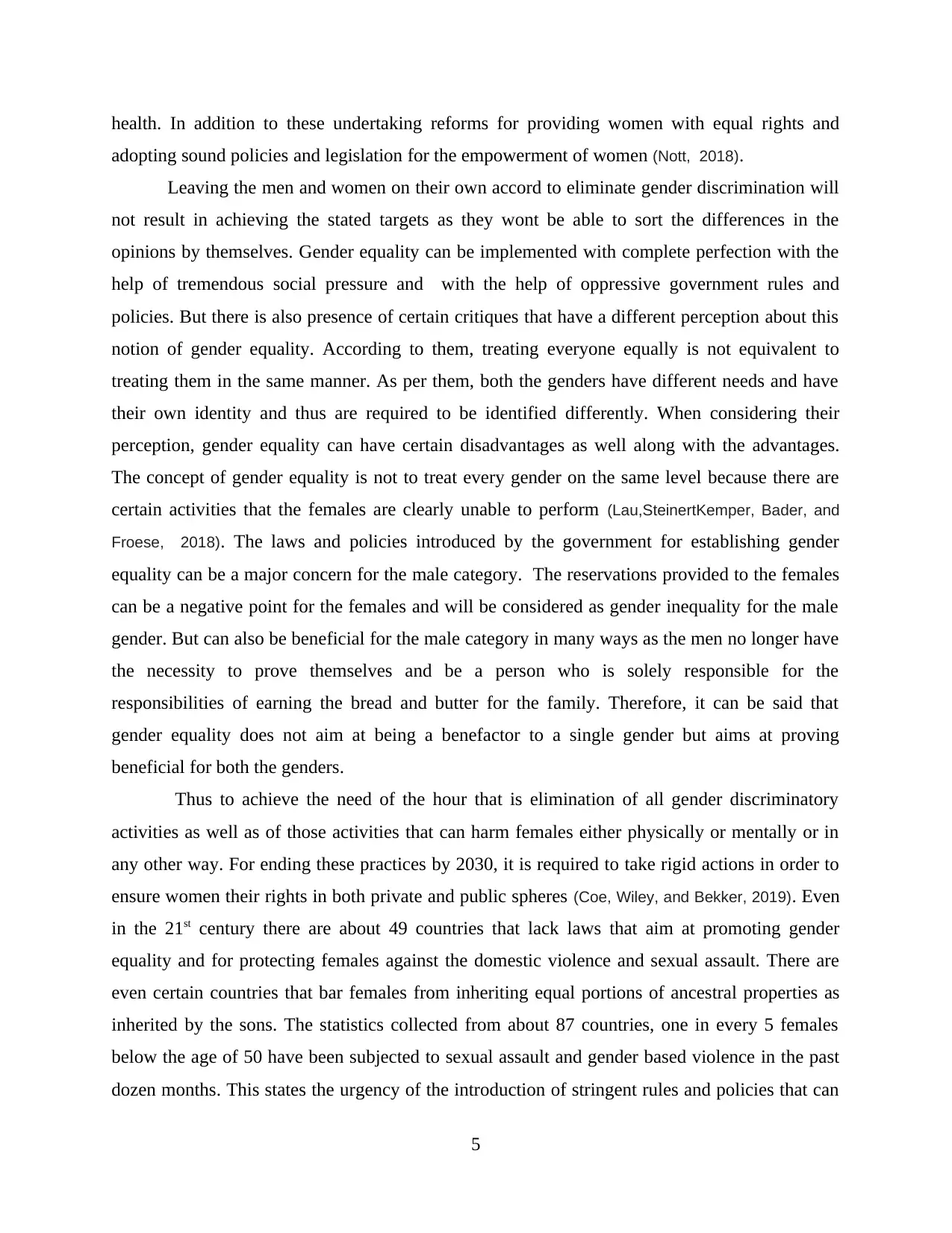
health. In addition to these undertaking reforms for providing women with equal rights and
adopting sound policies and legislation for the empowerment of women (Nott, 2018).
Leaving the men and women on their own accord to eliminate gender discrimination will
not result in achieving the stated targets as they wont be able to sort the differences in the
opinions by themselves. Gender equality can be implemented with complete perfection with the
help of tremendous social pressure and with the help of oppressive government rules and
policies. But there is also presence of certain critiques that have a different perception about this
notion of gender equality. According to them, treating everyone equally is not equivalent to
treating them in the same manner. As per them, both the genders have different needs and have
their own identity and thus are required to be identified differently. When considering their
perception, gender equality can have certain disadvantages as well along with the advantages.
The concept of gender equality is not to treat every gender on the same level because there are
certain activities that the females are clearly unable to perform (Lau,SteinertKemper, Bader, and
Froese, 2018). The laws and policies introduced by the government for establishing gender
equality can be a major concern for the male category. The reservations provided to the females
can be a negative point for the females and will be considered as gender inequality for the male
gender. But can also be beneficial for the male category in many ways as the men no longer have
the necessity to prove themselves and be a person who is solely responsible for the
responsibilities of earning the bread and butter for the family. Therefore, it can be said that
gender equality does not aim at being a benefactor to a single gender but aims at proving
beneficial for both the genders.
Thus to achieve the need of the hour that is elimination of all gender discriminatory
activities as well as of those activities that can harm females either physically or mentally or in
any other way. For ending these practices by 2030, it is required to take rigid actions in order to
ensure women their rights in both private and public spheres (Coe, Wiley, and Bekker, 2019). Even
in the 21st century there are about 49 countries that lack laws that aim at promoting gender
equality and for protecting females against the domestic violence and sexual assault. There are
even certain countries that bar females from inheriting equal portions of ancestral properties as
inherited by the sons. The statistics collected from about 87 countries, one in every 5 females
below the age of 50 have been subjected to sexual assault and gender based violence in the past
dozen months. This states the urgency of the introduction of stringent rules and policies that can
5
adopting sound policies and legislation for the empowerment of women (Nott, 2018).
Leaving the men and women on their own accord to eliminate gender discrimination will
not result in achieving the stated targets as they wont be able to sort the differences in the
opinions by themselves. Gender equality can be implemented with complete perfection with the
help of tremendous social pressure and with the help of oppressive government rules and
policies. But there is also presence of certain critiques that have a different perception about this
notion of gender equality. According to them, treating everyone equally is not equivalent to
treating them in the same manner. As per them, both the genders have different needs and have
their own identity and thus are required to be identified differently. When considering their
perception, gender equality can have certain disadvantages as well along with the advantages.
The concept of gender equality is not to treat every gender on the same level because there are
certain activities that the females are clearly unable to perform (Lau,SteinertKemper, Bader, and
Froese, 2018). The laws and policies introduced by the government for establishing gender
equality can be a major concern for the male category. The reservations provided to the females
can be a negative point for the females and will be considered as gender inequality for the male
gender. But can also be beneficial for the male category in many ways as the men no longer have
the necessity to prove themselves and be a person who is solely responsible for the
responsibilities of earning the bread and butter for the family. Therefore, it can be said that
gender equality does not aim at being a benefactor to a single gender but aims at proving
beneficial for both the genders.
Thus to achieve the need of the hour that is elimination of all gender discriminatory
activities as well as of those activities that can harm females either physically or mentally or in
any other way. For ending these practices by 2030, it is required to take rigid actions in order to
ensure women their rights in both private and public spheres (Coe, Wiley, and Bekker, 2019). Even
in the 21st century there are about 49 countries that lack laws that aim at promoting gender
equality and for protecting females against the domestic violence and sexual assault. There are
even certain countries that bar females from inheriting equal portions of ancestral properties as
inherited by the sons. The statistics collected from about 87 countries, one in every 5 females
below the age of 50 have been subjected to sexual assault and gender based violence in the past
dozen months. This states the urgency of the introduction of stringent rules and policies that can
5
⊘ This is a preview!⊘
Do you want full access?
Subscribe today to unlock all pages.

Trusted by 1+ million students worldwide
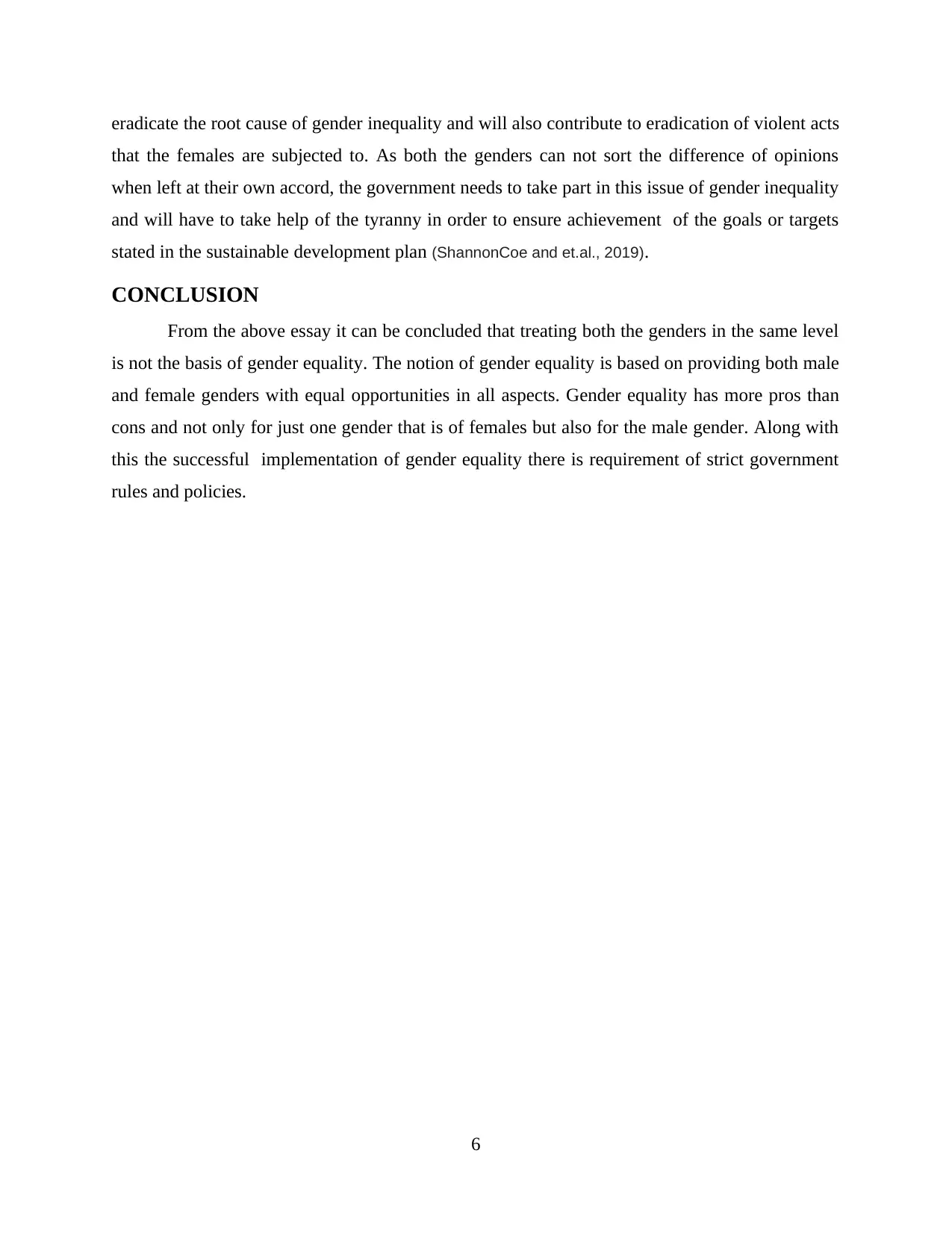
eradicate the root cause of gender inequality and will also contribute to eradication of violent acts
that the females are subjected to. As both the genders can not sort the difference of opinions
when left at their own accord, the government needs to take part in this issue of gender inequality
and will have to take help of the tyranny in order to ensure achievement of the goals or targets
stated in the sustainable development plan (ShannonCoe and et.al., 2019).
CONCLUSION
From the above essay it can be concluded that treating both the genders in the same level
is not the basis of gender equality. The notion of gender equality is based on providing both male
and female genders with equal opportunities in all aspects. Gender equality has more pros than
cons and not only for just one gender that is of females but also for the male gender. Along with
this the successful implementation of gender equality there is requirement of strict government
rules and policies.
6
that the females are subjected to. As both the genders can not sort the difference of opinions
when left at their own accord, the government needs to take part in this issue of gender inequality
and will have to take help of the tyranny in order to ensure achievement of the goals or targets
stated in the sustainable development plan (ShannonCoe and et.al., 2019).
CONCLUSION
From the above essay it can be concluded that treating both the genders in the same level
is not the basis of gender equality. The notion of gender equality is based on providing both male
and female genders with equal opportunities in all aspects. Gender equality has more pros than
cons and not only for just one gender that is of females but also for the male gender. Along with
this the successful implementation of gender equality there is requirement of strict government
rules and policies.
6
Paraphrase This Document
Need a fresh take? Get an instant paraphrase of this document with our AI Paraphraser
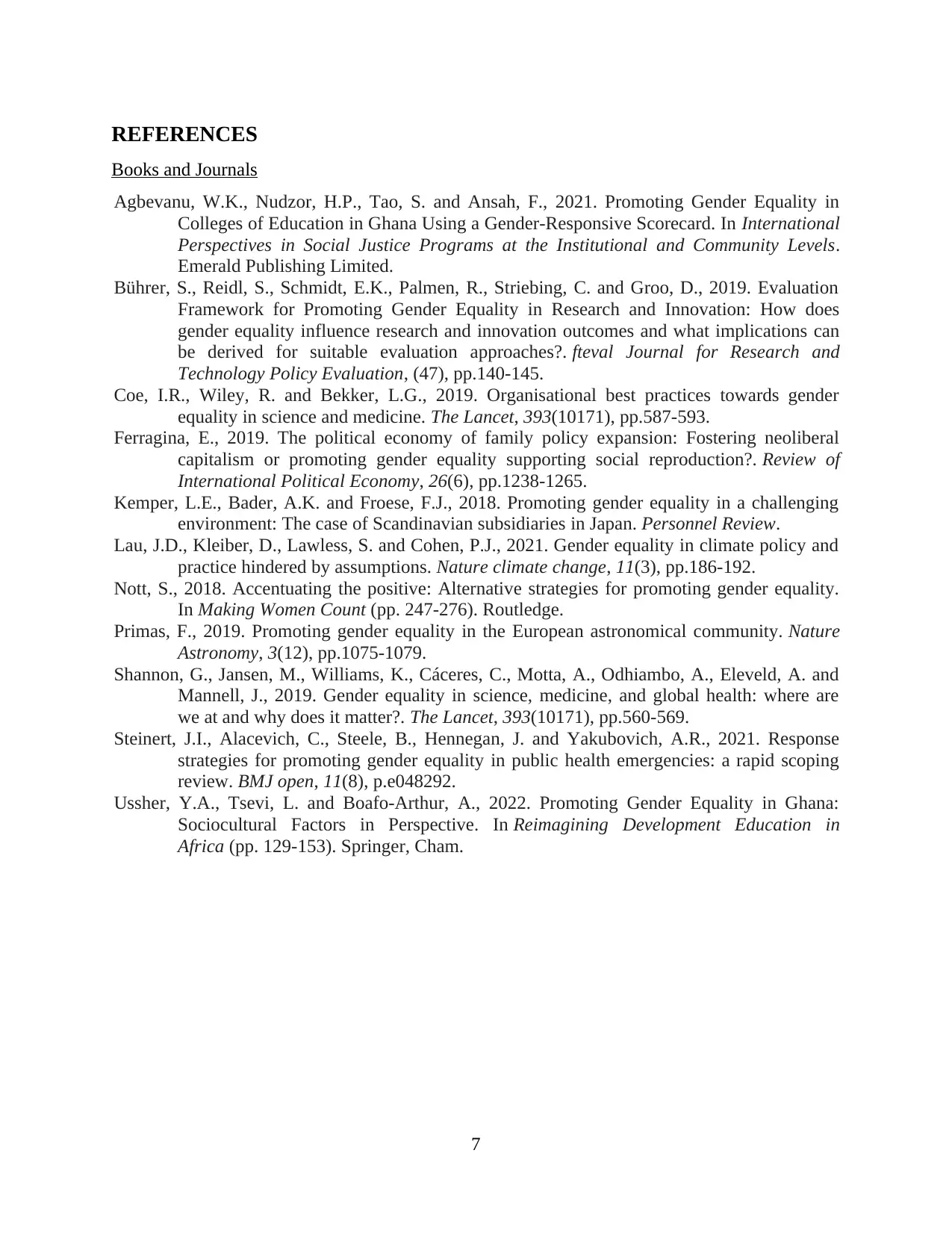
REFERENCES
Books and Journals
Agbevanu, W.K., Nudzor, H.P., Tao, S. and Ansah, F., 2021. Promoting Gender Equality in
Colleges of Education in Ghana Using a Gender-Responsive Scorecard. In International
Perspectives in Social Justice Programs at the Institutional and Community Levels.
Emerald Publishing Limited.
Bührer, S., Reidl, S., Schmidt, E.K., Palmen, R., Striebing, C. and Groo, D., 2019. Evaluation
Framework for Promoting Gender Equality in Research and Innovation: How does
gender equality influence research and innovation outcomes and what implications can
be derived for suitable evaluation approaches?. fteval Journal for Research and
Technology Policy Evaluation, (47), pp.140-145.
Coe, I.R., Wiley, R. and Bekker, L.G., 2019. Organisational best practices towards gender
equality in science and medicine. The Lancet, 393(10171), pp.587-593.
Ferragina, E., 2019. The political economy of family policy expansion: Fostering neoliberal
capitalism or promoting gender equality supporting social reproduction?. Review of
International Political Economy, 26(6), pp.1238-1265.
Kemper, L.E., Bader, A.K. and Froese, F.J., 2018. Promoting gender equality in a challenging
environment: The case of Scandinavian subsidiaries in Japan. Personnel Review.
Lau, J.D., Kleiber, D., Lawless, S. and Cohen, P.J., 2021. Gender equality in climate policy and
practice hindered by assumptions. Nature climate change, 11(3), pp.186-192.
Nott, S., 2018. Accentuating the positive: Alternative strategies for promoting gender equality.
In Making Women Count (pp. 247-276). Routledge.
Primas, F., 2019. Promoting gender equality in the European astronomical community. Nature
Astronomy, 3(12), pp.1075-1079.
Shannon, G., Jansen, M., Williams, K., Cáceres, C., Motta, A., Odhiambo, A., Eleveld, A. and
Mannell, J., 2019. Gender equality in science, medicine, and global health: where are
we at and why does it matter?. The Lancet, 393(10171), pp.560-569.
Steinert, J.I., Alacevich, C., Steele, B., Hennegan, J. and Yakubovich, A.R., 2021. Response
strategies for promoting gender equality in public health emergencies: a rapid scoping
review. BMJ open, 11(8), p.e048292.
Ussher, Y.A., Tsevi, L. and Boafo-Arthur, A., 2022. Promoting Gender Equality in Ghana:
Sociocultural Factors in Perspective. In Reimagining Development Education in
Africa (pp. 129-153). Springer, Cham.
7
Books and Journals
Agbevanu, W.K., Nudzor, H.P., Tao, S. and Ansah, F., 2021. Promoting Gender Equality in
Colleges of Education in Ghana Using a Gender-Responsive Scorecard. In International
Perspectives in Social Justice Programs at the Institutional and Community Levels.
Emerald Publishing Limited.
Bührer, S., Reidl, S., Schmidt, E.K., Palmen, R., Striebing, C. and Groo, D., 2019. Evaluation
Framework for Promoting Gender Equality in Research and Innovation: How does
gender equality influence research and innovation outcomes and what implications can
be derived for suitable evaluation approaches?. fteval Journal for Research and
Technology Policy Evaluation, (47), pp.140-145.
Coe, I.R., Wiley, R. and Bekker, L.G., 2019. Organisational best practices towards gender
equality in science and medicine. The Lancet, 393(10171), pp.587-593.
Ferragina, E., 2019. The political economy of family policy expansion: Fostering neoliberal
capitalism or promoting gender equality supporting social reproduction?. Review of
International Political Economy, 26(6), pp.1238-1265.
Kemper, L.E., Bader, A.K. and Froese, F.J., 2018. Promoting gender equality in a challenging
environment: The case of Scandinavian subsidiaries in Japan. Personnel Review.
Lau, J.D., Kleiber, D., Lawless, S. and Cohen, P.J., 2021. Gender equality in climate policy and
practice hindered by assumptions. Nature climate change, 11(3), pp.186-192.
Nott, S., 2018. Accentuating the positive: Alternative strategies for promoting gender equality.
In Making Women Count (pp. 247-276). Routledge.
Primas, F., 2019. Promoting gender equality in the European astronomical community. Nature
Astronomy, 3(12), pp.1075-1079.
Shannon, G., Jansen, M., Williams, K., Cáceres, C., Motta, A., Odhiambo, A., Eleveld, A. and
Mannell, J., 2019. Gender equality in science, medicine, and global health: where are
we at and why does it matter?. The Lancet, 393(10171), pp.560-569.
Steinert, J.I., Alacevich, C., Steele, B., Hennegan, J. and Yakubovich, A.R., 2021. Response
strategies for promoting gender equality in public health emergencies: a rapid scoping
review. BMJ open, 11(8), p.e048292.
Ussher, Y.A., Tsevi, L. and Boafo-Arthur, A., 2022. Promoting Gender Equality in Ghana:
Sociocultural Factors in Perspective. In Reimagining Development Education in
Africa (pp. 129-153). Springer, Cham.
7
1 out of 8
Related Documents
Your All-in-One AI-Powered Toolkit for Academic Success.
+13062052269
info@desklib.com
Available 24*7 on WhatsApp / Email
![[object Object]](/_next/static/media/star-bottom.7253800d.svg)
Unlock your academic potential
Copyright © 2020–2025 A2Z Services. All Rights Reserved. Developed and managed by ZUCOL.


